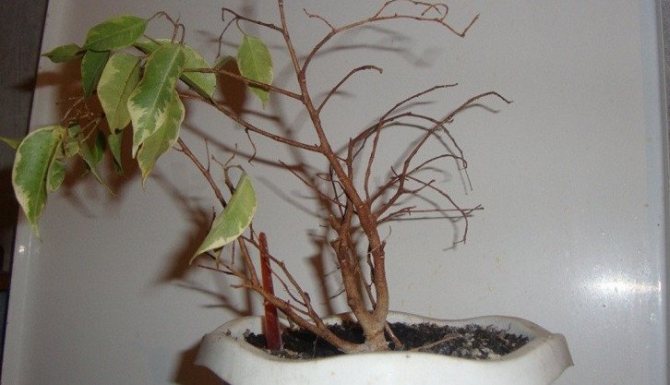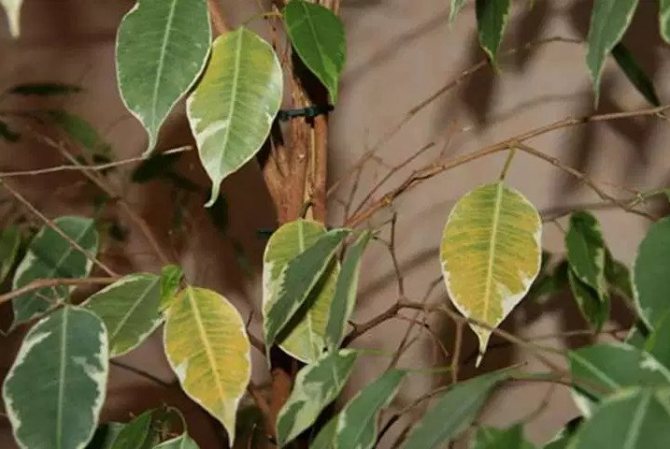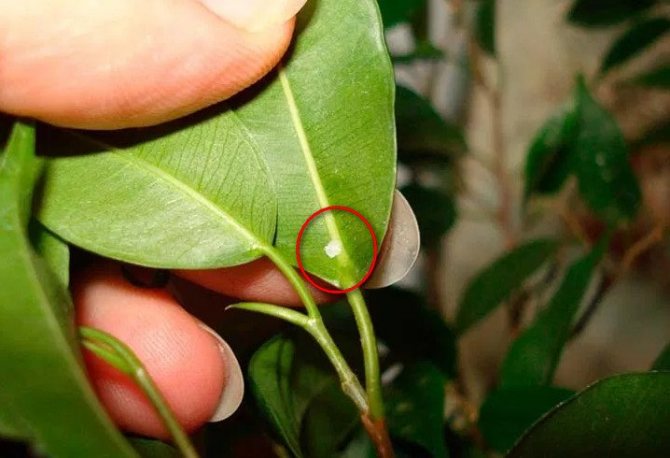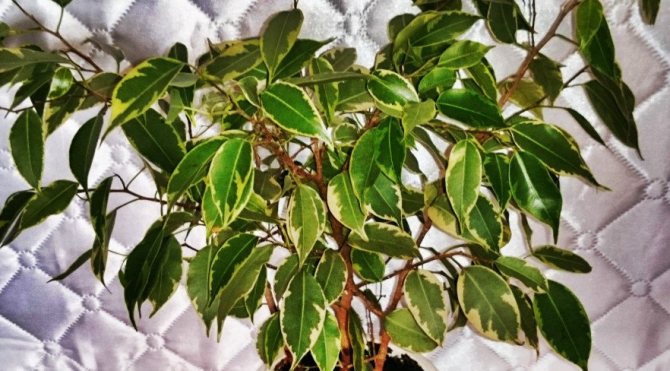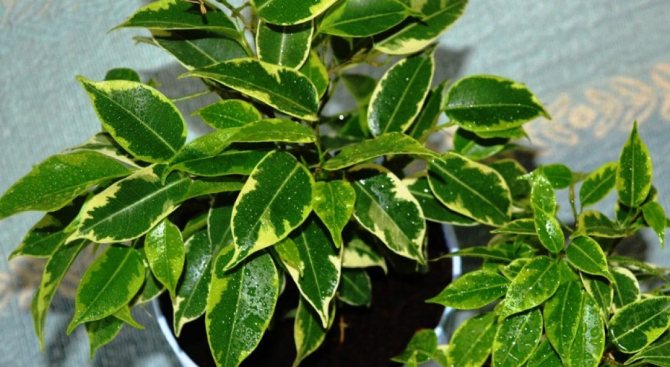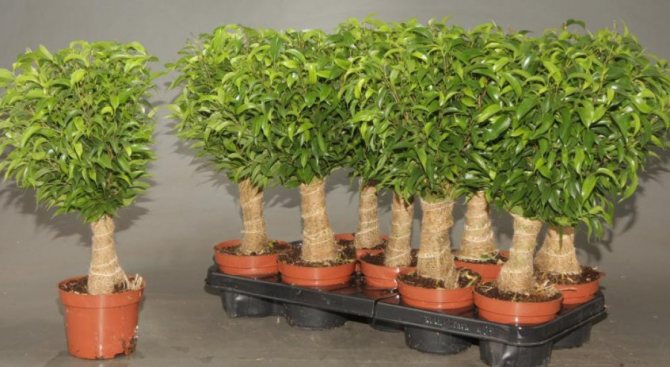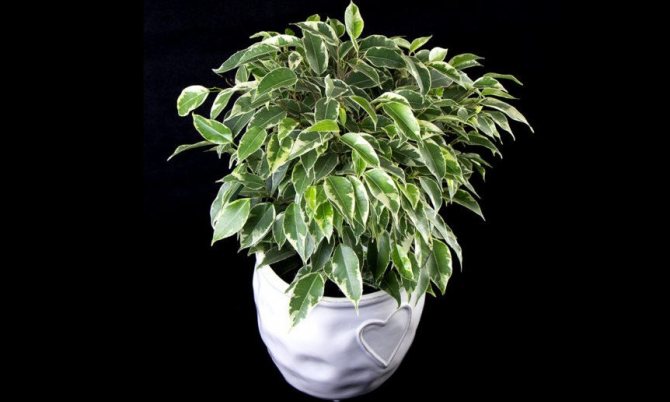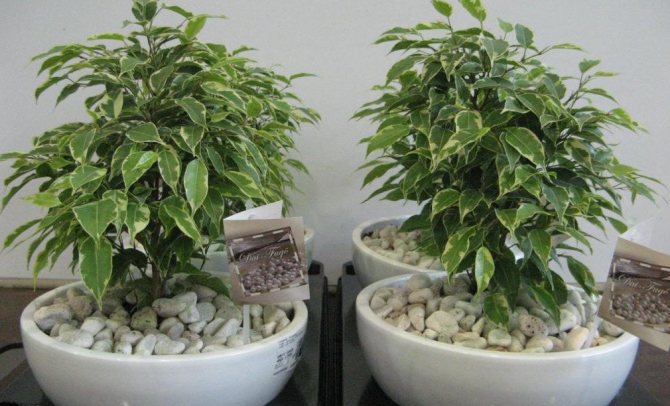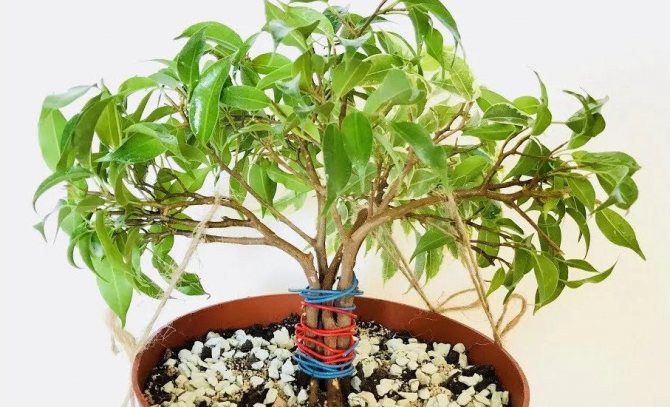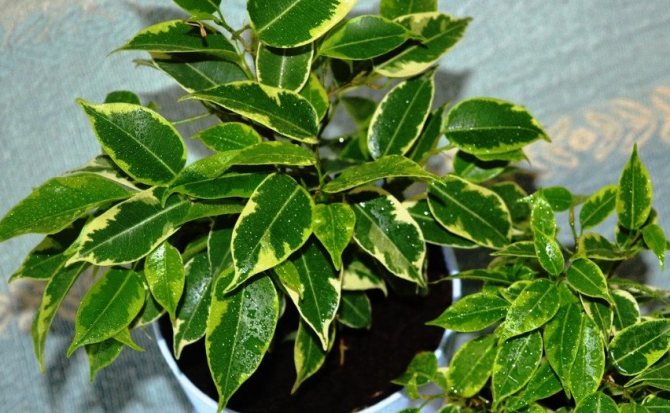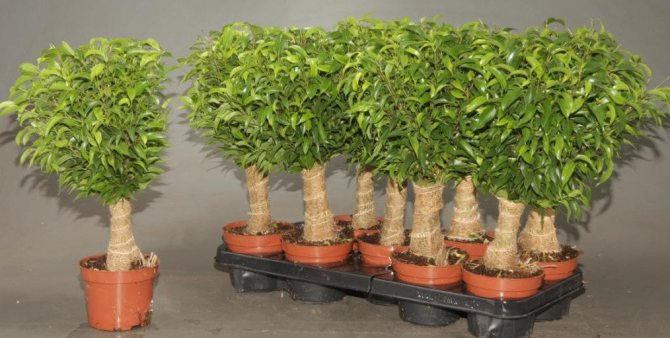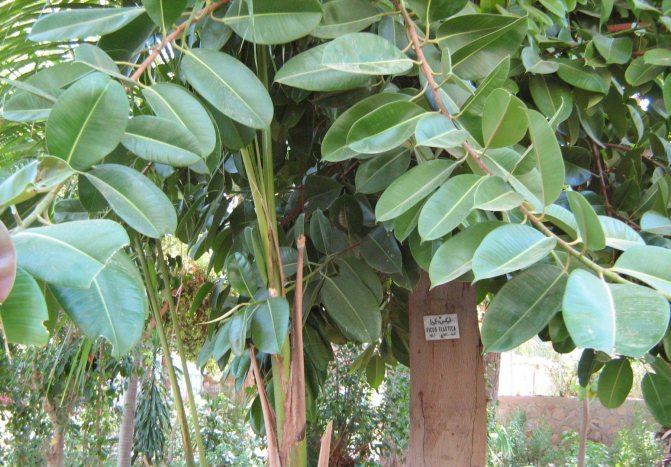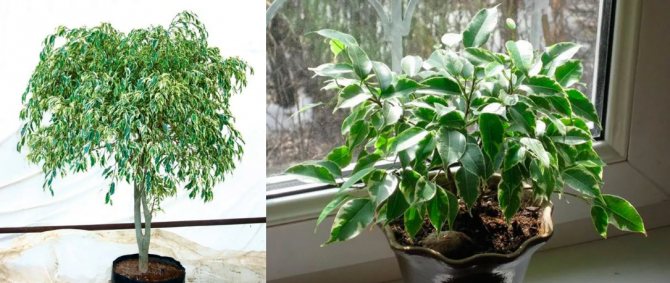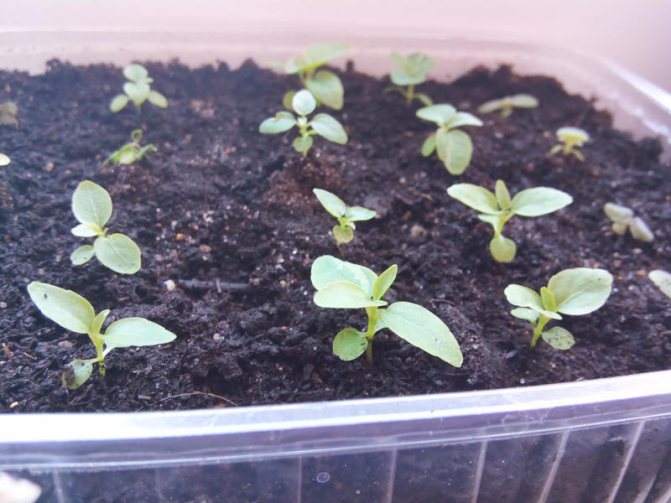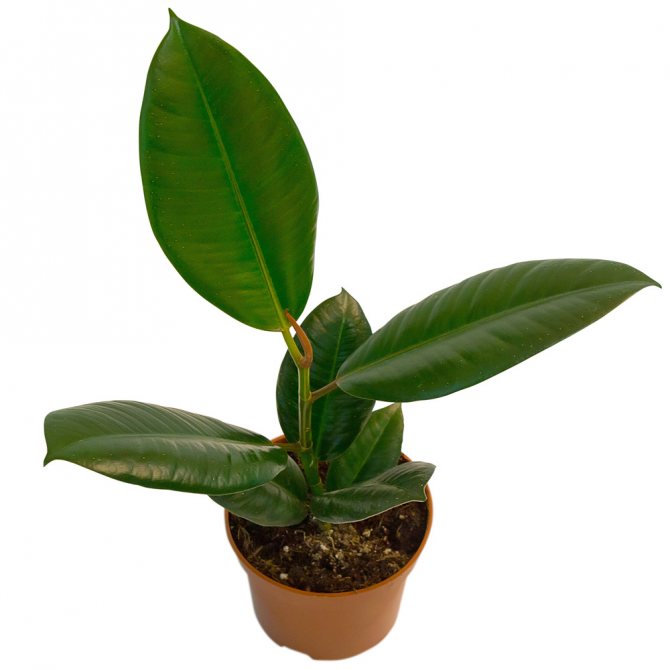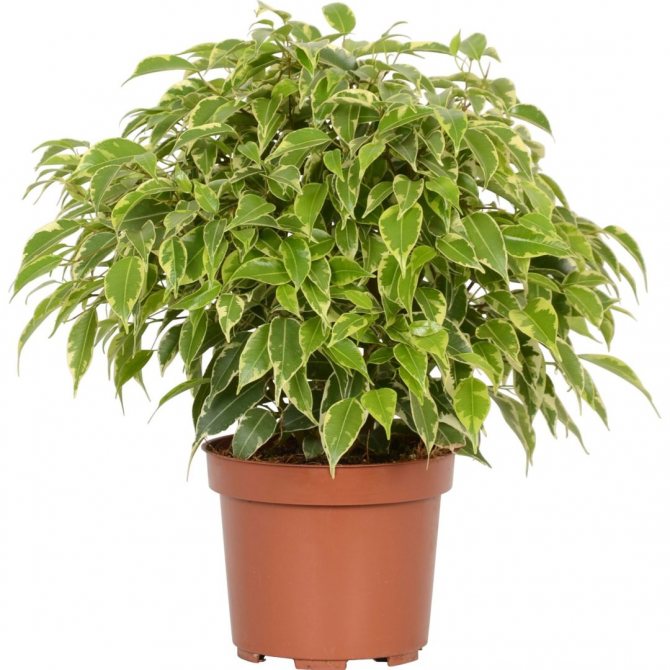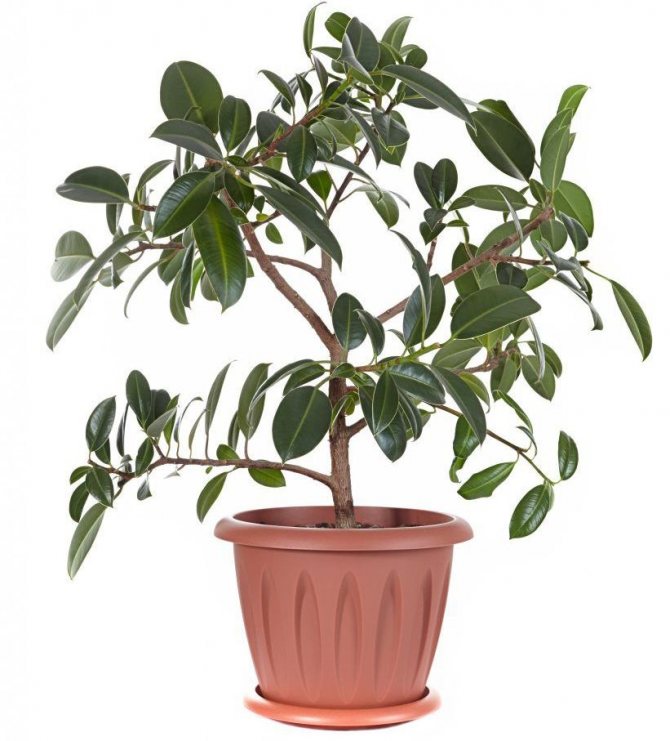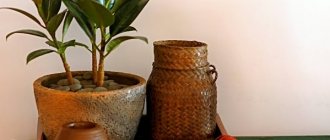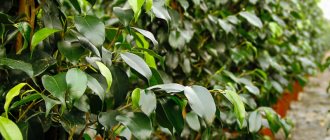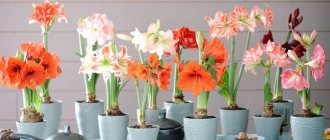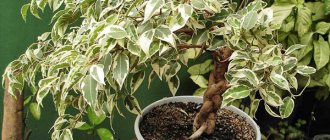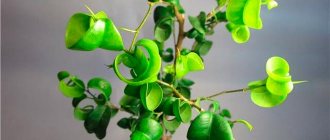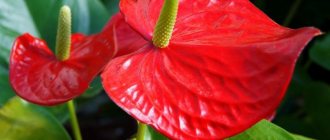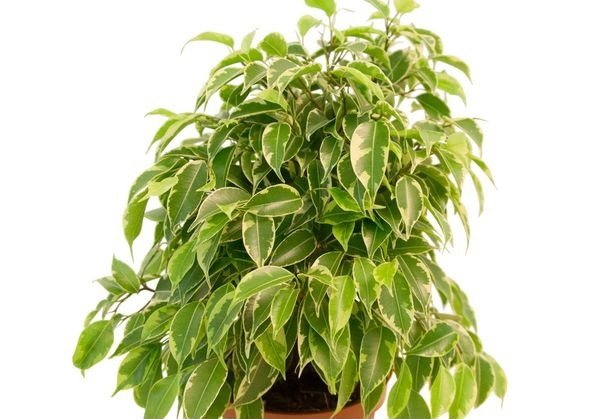
Ficus Kinki is miniature version of Benjamin and belongs to the Mulberry family. Plants of this variety are often found in the form of a shrub or low tree. It does not need special care if you follow the simple rules of its cultivation.
Since Kinki originally from the tropics - West Africa, Australia and Asia - for good growth it needs conditions close to tropical.
How to properly care for Kinki ficus?
The plant requires sufficiently thorough care, in the absence of which it can, at best, lose its decorative effect, and at worst, it can die. The owner of the ficus Kinki is required to:
- water it regularly;
- fertilize and replant the growing tree in a timely manner;
- maintain a stable temperature and light conditions.
Transfer after purchase
During the acquisition of a plant, it should be carefully examined. A healthy ficus tree should not have the following symptoms:
- dry and falling leaves;
- traces of rot;
- visible damage;
- unpleasant odor from the soil (for example, mold).
The acquired plant needs a mandatory transplant into a new container. The pot can be ceramic or plastic. The main requirement is that it should fit the size of the flower, not be too large or too small.
When transplanting ficus for the first time, the soil is completely replaced, since the plants are usually sold in a specific peat mixture. It quickly wastes its nutritional properties and does not provide the ficus with the substances necessary for its development. In addition, the plant growing in peat is easy to pour, since the mixture looks dry on the outside, but inside it retains a large amount of moisture.
What kind of soil is needed?
The optimal choice for planting Kinki ficus will be loose soil that has a neutral pH level. It can be purchased from a specialist store.
If desired, it is possible to prepare the soil yourself by mixing the following components in equal quantities:
- sod soil;
- peat;
- organic fertilizer (humus);
- river sand of a coarse fraction.
At the bottom of the pot, a drainage layer must be arranged so that the roots do not rot.
Features of home care
The normal growth of the ficus Kinki is ensured by comfortable living conditions for it. The most important points of care are:
- Temperature conditions. Ficuses are thermophilic, the most suitable temperature for them would be + 19-22 ºC. Moreover, plants tolerate the summer heat quite easily, but in winter the temperature in the room should not fall below +16 ºС.
- Lack of drafts and hot air streams. Ficus should not be placed in close proximity to batteries and heaters.
- Air humidity. Ficuses are not very demanding on moisture indicators, but it will sometimes be useful to spray their crown with water.
- Lighting. This tropical plant is quite light-requiring. To obtain a variegated color of foliage, the tree needs bright diffused light, but direct sunlight affects it detrimentally. On hot summer days, it is advisable to shade Kinki a little. If there is a choice, the best place for the flower will be a window facing east or west.
- Watering. Kinky must be watered with settled water at room temperature.The frequency of watering depends on the rate of drying of the top layer of the soil in the pot.
- Top dressing. Fertilize the crop with an ordinary universal fertilizer for indoor plants. This should be done from about February to October, twice a month. From October, feeding is stopped, as the plant enters the resting phase. Fertilizing it at this time, you can only do harm.
- Transfer. After the first transplant, the ficus is not transplanted for about a year, allowing it to adapt. Then, once a year, transplants are carried out into a larger container. It is optimal to do this in February, before the plant matures. Adult ficus is transplanted less often, as needed. Such transplants no longer require a complete soil replacement. On the contrary, Kinki is transplanted with a clod of earth, taking care not to damage the roots.
It is also advisable not to rearrange the flower: the plant can hardly bear the change of "place of residence".
How to form a crown?
Ficus Kinki easily tolerates formation, so it can be given any shape - from spherical to the most intricate. It is advisable to ask it immediately, while the plant is young, and then it remains only to maintain. Kinki ficus should be cut during its active growth, in the spring.
Correct pruning must meet several requirements:
- it is carried out with a sharp sterile instrument;
- leaves cannot be torn off, they can only be cut off;
- it is important that the bark of the trunks is not damaged during pruning.
Is Kinki suitable for bonsai formation?
Ficus formation is not only about cutting its magnificent crown. Kinki is quite suitable for growing bonsai-style dwarf trees, for example:
- Hokidati - a tree of a natural, natural form;
- Syakan - a tree bent to one side;
- Tyokkan is a plant with a vertical, perfectly flat trunk and a rectangular crown;
- Sokan - multi-stemmed bonsai, consisting of two or more stems of different sizes;
- Moyogi is a tree with a vertical trunk, curved in several places, with a small crown.
Growing problems
Kinki ficus usually signals problems associated with improper care in the following ways:
- Dropping leaves. This may be the plant's reaction to drafts, hypothermia, lack of light, frequent rearrangements, excess fertilizer during the dormant period.
- Yellowing of the leaves. May appear when irrigation regime is violated.
- Slow growth. The plant stops growing if planted in a container that is too spacious. In this case, the process of development of its root system slows down.
What to do if ficus drops leaves?
If Kinki began to shed leaves, the conditions of its maintenance should be assessed and, if necessary, corrected:
- If the ficus after purchase remains in the transport soil, or the pot has become cramped for the plant, it should be transplanted immediately.
- If there are drafts, you need to rearrange the pot to another place.
- It is necessary to analyze the air temperature in the room and the temperature of the water with which the ficus is watered.
- Direct sunlight on the tree should be eliminated.
Reproduction
At home, ficus Kinki is propagated by cuttings or layering. Cuttings are carried out in the spring-summer period:
- Cut off the apical shoots with 2-3 leaves about 10 cm long.
- The released juice is washed off the shoots and dried a little in the air.
- The cuttings are buried about 2 cm in a mixture of peat and sand and covered with a plastic cap.
- After the appearance of new leaves on the cuttings, the plants are transplanted into ordinary soil.
Instead of a sand-peat mixture, the cuttings can be placed in a container with water and wait for the roots to appear (usually the wait takes about 2 weeks). Reproduction by layering is carried out in the summer.
To do this, you need to do the following:
- A circular incision is made on the selected shoot.
- The damaged area is wrapped in wet moss, which is fixed with tape.
- When the moss is filled with roots, the shoot is cut off and planted in the ground.
Diseases and pests
Like any indoor crop, Kinky can attack fungi, infections and pests. The most common ones are:
- Shield aphid or spider mite - effective insecticides from a specialized store will help in the fight against them.
- Powdery mildew - white bloom on the leaves. It is required to remove the affected foliage and treat the plant with a fungicide solution.
- Root rot - appears due to infection with harmful bacteria. It is necessary to completely replace the soil, while removing rotten roots.
Diseases and pests
Drops leaves, what to do?
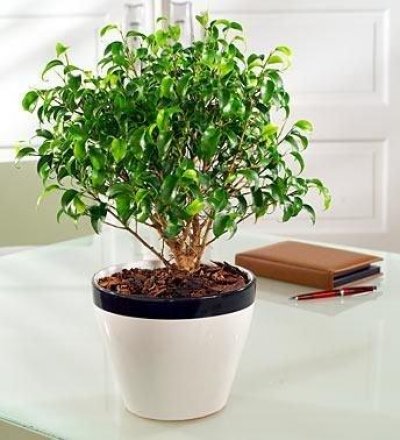

Like any other plant, it can get sick.
This can be expressed in yellowing and even subsequent leaf fall.
This can occur for the following reasons:
- insufficient illumination;
- excess moisture;
- stress caused by a change of location and relocation;
- low air temperature;
- use of cold water for irrigation;
- drafts and sudden temperature changes.
The ficus may look completely healthy, but not grow in size. This may be due to the fact that the pot did not fit the plant in size.
For reference: if the crown does not grow in the ficus, it must be transplanted into a more spacious container. But too large dishes lead to a deterioration of the root system, which does not allow the plant to develop.
There are other causes of disease. Pests (spider mites, aphids) that arise from too dry indoor air.
Important: rinse the plant under warm water and treat with special products.
Putrefactive bacteria - cause root rot.
Do not forget! transplant ficus and remove the affected parts of the roots.
Powdery mildew - appears on kinky leaves.
Important: tear off the infected leaves and treat with a fungicide to prevent the spread of the disease.
Ficus kinki is very unpretentious in care, but nevertheless it is necessary to observe certain conditions so that it pleases the eye with its healthy and beautiful appearance for a long time.
Signs and superstitions
Ficus is the hero of many superstitions and accepts, sometimes quite contradictory. Of the positive qualities attributed to the plant, the following are best known:
- This plant is an excellent source of vivacity and vitality, therefore it will be an excellent gift for a loved one.
- The flower is able to protect the house from evil forces and ill-wishers.
- Having placed the ficus in the matrimonial bedroom, you can expect an early addition to the family.
There are also bad omens:
- A native of the tropics - a symbol of strife, he can generate rumors and gossip around his owners.
- The presence of ficus can spoil the character of a man living in a house.
- If an unmarried woman gets a plant, she will face difficulties in her personal life and a lack of serious relationships.
Which of these will accept to believe and whether to start a ficus in the house - each person decides for himself.


Before purchasing a flower, many people are guided by the superstitions and omens associated with them. Beliefs can be not only positive, but also negative. There are also signs and superstitions about Benjamin's ficus, which is a popular plant.
If bloomed
Many superstitions are associated with the flowering of indoor plants, and real legends go about the flowers of ficus. Moreover, in some peoples, the appearance of inflorescences on it indicates a future increase in the financial well-being of the owner, while in others, the addition of a family.
The sign associated with the emergence of a new life is widely known to both the Slavs and the Eastern peoples. It's believed that if the ficus has bloomed, it means that soon its owner will become pregnant.
It is customary to expect the same result if the ficus gave rise to a shoot.The emergence of young shoots symbolizes new life.
What does the flower symbolize
Various signs and superstitions are associated with the ficus flower. This is partly due to the fact that ficus is considered a common indoor flower. However, many growers are only superficially aware of the signs and superstitions that are associated with it.
According to well-known signs and superstitions, not every plant can be kept at home. Moreover, if there are children in the family. Some couples study superstitions or superstitions carefully before planning a pregnancy. Beliefs also apply to ficus.
Under natural conditions, the tree reaches a height of several meters and experiences drought and rain. During a drought, the ficus sheds its leaves to reduce the need for moisture.
Conditions and features of care
For planting a plant, the ficus soil, which is sold in flower shops, is perfect. The plant needs to provide good drainage... To do this, a layer of expanded clay is poured onto the bottom of the pot, then a layer of sand and soil on top.
Ficus Benjamin Kinky likes good lighting, it is best if the light is diffused. It is necessary to immediately choose a place for the pot and not rearrange it in order to protect the flower from stress and leaf fall. The ideal place would be window sill on the east or west sideprotected from direct sunlight. The optimum room temperature is 15-20 degrees.
For normal development the air in the room should not be dry... Periodically, you should spray the crown from a spray bottle or give the plant a warm shower, covering the soil from moisture.
Kinki is very picky about watering. You need to perform this procedure with standing water at room temperature only when the top layer of earth in the pot dries slightly... Watering too often can cause root rot. From a long drought, leaves will fly around.
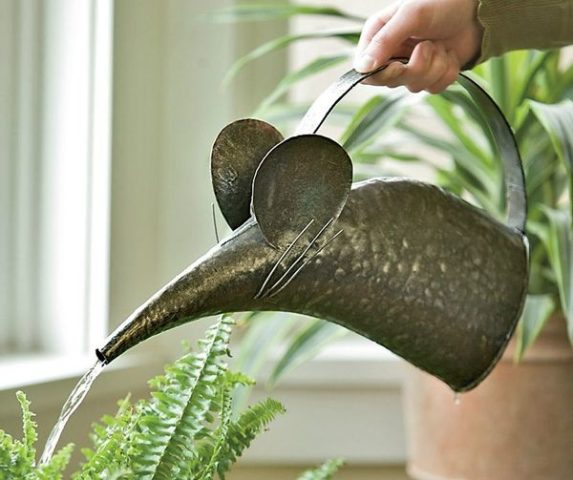

Watering indoor ficus Kinki
Therefore, it is very important to observe the measure. In the spring time of intensive growth of ficus is useful 1-2 times a month add into water for irrigation complex fertilizer for variegated indoor plants.
Reproduction and transplantation of home Benjamin
The first ficus transplant is performed after its purchase.... The shipping pot and store substrate are not suitable for permanent growth. The planting container should not be too large. For a small cutting, a pot with a diameter of about 10 cm is sufficient.
Further, as it grows, ficus is transplanted by the transshipment method, leaving a lump of old earth around the roots. The resulting voids are filled with fresh soil.
Ficus Kinki propagates seeds, apical cuttings and pieces of stems... At home, the easiest way is to root a branch about 10 cm long, on which 3-4 leaves are left. Such a shoot can be placed in water or planted in a mixture of soil and sand, covered with a plastic cap on top. Roots appear in 10-15 days.
Diseases and pests: what to do if the ficus begins to shed its leaves
Dangerous pests for Kinki are scale insect, spider mite, mealybug, aphid... What to do when the ficus begins to shed its foliage due to illness? If the plant turns out to be infected, it should be carefully rinse it with warm water under the showerwithout forgetting to cover the soil in the pot.
When such a procedure does not help, pest control is necessary with the help of store-bought chemicals. A sure sign that your ficus don't like environmental conditions, serves falling leaves... There are many reasons for this. Here are the main ones:
- air temperature below 15 degrees;
- a pot with a flower too close to the battery or in a draft;
- tooabundant or inadequatewatering;
- plant little light;
- ficus pot often carried from place to place.
Ficus at home: good or bad
Since the tree has been cultivated for many years, there are many signs and superstitions associated with it. Experts have proven the positive effect of the plant on health. A small tree purifies the air, acting as a kind of filter.
A variety of Benjamin helps to eliminate microbes, negative particles in the air and oxygenate it. The flower can be grown in residential areas of large cities.
What does ficus bring to the house
Initially, the Slavic peoples did not give preference to a beautiful plant. It was believed that the ficus awakens negative emotions in a person. The tree was a sign of gossip, envy.
The influence of other countries contributed to a change in superstitions and superstitions. Currently, it is believed that the plant brings goodness and happiness, strengthens the family. A small tree improves the energy of a house or apartment.
Is it possible to keep a ficus at home for an unmarried girl
Ficus Benjamin, located in the house, according to superstition, scared men away from girls. An unfavorable omen warned that the girl growing the tree would not marry.
It is noteworthy that a ficus, for example, Benjamin's, had a negative effect on men. Given common superstition, people did not want to grow a tree.
To whom and why the ficus can not be kept at home
In addition to signs and superstitions, individual allergic reactions, which are due to the presence of milky juice, must be taken into account. In case of severe allergies, keeping the ficus at home is not recommended. Ignoring severe allergic reactions can lead to asthma.
Transplantation and reproduction of ficus
It is imperative to transplant the plant after purchase, given that the soil mixture in the purchased ficus does not contain a sufficient amount of nutrients. For these purposes, you will need:
- Prepare a suitable ceramic or plastic container.
- Treat it with a weak solution of potassium permanganate.
- Water the plant well.
- Together with the earthy lump, transfer it to a new flower vessel, having previously laid a drainage layer of fine expanded clay on the bottom.
- The resulting voids in the vessel must be filled with fertile soil.
- Moisten the flower abundantly.
In the future, the flower culture is transplanted as needed, when the roots are already visible through the drainage holes.
There are several ways to breed Kinki ficus: by seed or cuttings. The second option is distinguished by high performance in home content. To begin with, cut a stalk 10-15 cm long from the lignified shoot or top. Then they give him a couple of hours to dry out from the milky juice that was released on the cut.
The workpiece is placed in a container with soft and settled water and wait until the roots begin to form. Then the cutting is planted in a pot with loose and nutritious soil.
The magical properties of the plant
In some countries (China, Thailand), Benjamin's ficus is referred to as a sacred plant. Happiness and good luck awaits the owner of a beautiful flower. It is a source of comfort and a pleasant atmosphere. In addition, a beautiful tree can cleanse a person's home of negative emotions.
Ficus Benjamin is often purchased for the purpose of replenishing the family. Signs and superstitions for the home associated with a ficus say that for a successful conception, you can even borrow a ficus. However, the omen is valid only in the case of good plant care. To conceive, you need to treat the tree like a child.
Can I donate?
It all depends on a person's preferences, or his individual attitude to signs. If he is not inclined to believe them, then the ficus will be a wonderful gift for both sexes for any occasion. And in order for the plant to really bring joy to the donee, you need to buy it in high spirits. This way you can share your energy with him.
It will be great if you yourself receive a flower as a gift. The one acquired independently does not have such a powerful energy as donated with pure intentions. If you want a really strong plant, ask for a flower as a gift. from a close and loving person.
Varieties of ficuses: photos, names and signs
The plant belongs to the Mulberry family and is also known as the "weeping tree". Ficus comes in many varieties. Experts count about 900 plant species. A significant part of ficuses grows in the subtropics and tropics. The following varieties are grown at home:
Signs and superstitions about Benjamin's ficus
It is believed that it was with the leaves of Benjamin's ficus that Adam and Eve covered themselves after their expulsion by God from the Garden of Eden. Thus, superstitions and omens about Benjamin's ficus (variety "Natasha") also developed as a result of various historical events.
At home, Benjamin's ficus is more often grown. It is an evergreen tree growing up to 20 m (in the wild). The beautiful green leaves have a smooth surface.
Popular varieties of Benjamin ficus include:
Signs and superstitions about Benjamin's ficus are associated with whether it is possible to grow a tree at home. The health benefits of the plant are also essential.
Signs and superstitions about rubber ficus
People are divided about this species. Some signs say that the rubbery look brings happiness. While, according to other superstitions, it is not recommended to grow a flower at home or in an apartment.
There is a sign that the rubber-bearing variety can be called muzhegon. Thus, men do not live long in the house where this flower grows. If you donate it for a wedding celebration, the marriage will not last long. It is undesirable to keep the rubbery variety in the house not only for married couples, but also for single girls. The flower will scare off potential suitors.
According to some superstitions, the rubbery species attracts money. It should be started by people who urgently need to resolve the money issue. To make the omen come true, the tree is placed in the office or on the table. This localization contributes to increased income and career growth.
It is possible to place a rubber variety in the kitchen to attract wealth and prosperity. An unpretentious flower helps to get pregnant and carry a baby, as well as facilitate childbirth.
Signs and superstitions about the ficus Robusta
Ficus elastica, for example, Robusta, is considered common because of its beautiful appearance and good omens. The plant differs from ficus Benjamin in large dense leaves of a dark green color. Due to the large leaves, the flower looks quite impressive. That is why it can often be found in apartments and office buildings.
Leaves absorb bad energy like a sponge. Experts say that the flower not only purifies the air, but is also beneficial for the gastrointestinal tract. This arrangement helps to accumulate positive energy. The atmosphere in the apartment and the house becomes calm.
Signs and superstitions about the ficus Melanie
This is a relatively new variety that grows in a compact bush. The plant is recommended by an inexperienced grower because of its unpretentiousness. The disadvantages of the variety include the almost complete absence of flowering at home. To eliminate fatigue, the pot is placed near the work table. To attract guests, the Melanie variety is placed in the corridor.
The Melanie variety restores the harmony of intimate relationships when localized in the bedroom. It should be borne in mind that it is undesirable to place the tree in the center of the room.
Signs and superstitions about the ficus Kinki
It is a dwarf form of the famous Benjamin ficus. Height is up to 40 cm. Small, narrow leaves are colored light green. Flower care is simple. You can easily form a bush from it.
The Kinki variety is considered a great gift.The flower has power, driving away evil forces from its owner. The tree is recommended to be placed in the bedroom when planning a pregnancy.
Trunk and crown formation
A distinctive feature of Kinki is elongated leaves from 3 to 7 cm long with variegated edges. Moreover, on one plant there may be leaves with a border of milky, grayish-white and even light green. Ficus can become a real highlight of the interior, if you have patience and give the original shape to its trunk or crown... Do this better in springwhen the flower is growing rapidly.
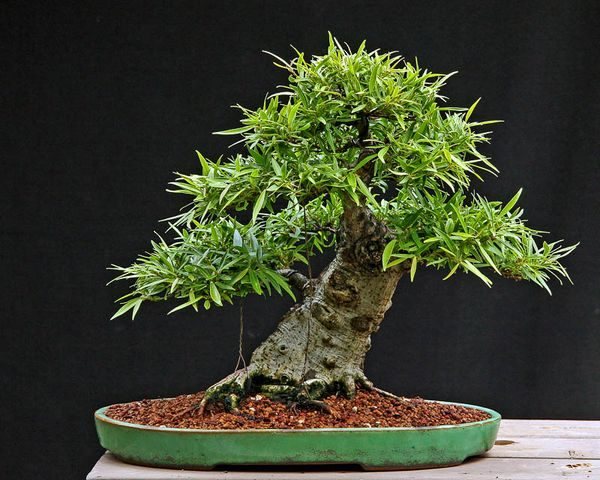

Shaping a bonsai crown
For weaving ficuses
To form a trunk, you need to plant several shoots in a pot next to it. Weaving should not be tight, so as to allow the trunks to grow in thickness.
Excess leaves are carefully trimmed, the weaving places are fixed with woolen threads. As it grows, weaving continues to the desired height.
Crone can be given view of a ball, cone, umbrella... The cuttings are allowed to grow, after which the excess branches are cut to the desired length and shape. Pruning is done as the ficus grows. By removing excess leaves and branches, pointing in the right direction and fixing the trunk many unusual options can be created.
The end result will depend on your imagination and skill.
Where is the best place to put the plant
There are also signs for the house associated with Benjamin's ficus. The location of the tree in the living space is important.
The flower can be placed on the east and south sides. The proximity to the light is important, since the energy of the tree can fully unfold. It will bring harmony and peace to the home.
In China, trees are placed on the windows. People are convinced that the flower harmonizes the home and gives comfort.
This plant is especially useful when placed in the kitchen. According to superstition, residents will not have to feel the need for food. For this purpose, it is recommended to bury a coin in a pot. Along with the growth of the tree, well-being increases. The family will always be loving and happy. The house will have prosperity and a comfortable atmosphere.
Ficus Benjamin, located in the kitchen, will help build relationships between relatives. Any variety is believed to help fight germs in the kitchen.
Signs also refer to Benjamin's ficus and pregnancy. If a woman plans to conceive a child, the plant should be placed in the bedroom. To make the man confident in his abilities, the tree is placed next to the bed.
There is a superstition that walking around the tree tub is conducive to conception. You can also ask for a scion from a family with children.
A small tree growing in the bedroom improves sleep and eliminates nightmares. If the plant is in the living room, it attracts important people to life.
Various types of unpretentious plants can be grown in office premises. A tree growing at work is a sign of a good mood. Flowers help you focus and focus.
Positive signs
The plant's energy is said to help in certain areas of life.
To attract finance:


- The shrub should be transplanted into a green pot, pasted over with special materials;
- Bury two gold coins of different denominations between the roots;
- Water regularly, spray and talk with gentle intonation.
Read:
Signs about money
To be lucky in love:


- Take a pink or red flowerpot for transplant, but choose not plastic, but ceramics;
- Decorate the container with glued paper hearts;
- Bury a figurine of a heart inside;
- Courting with attention, not hesitating to ask for needs;
- Making a wish about personal things on Birthday, February 14 and July 8 - the day of family, love and fidelity.


For pregnancy:
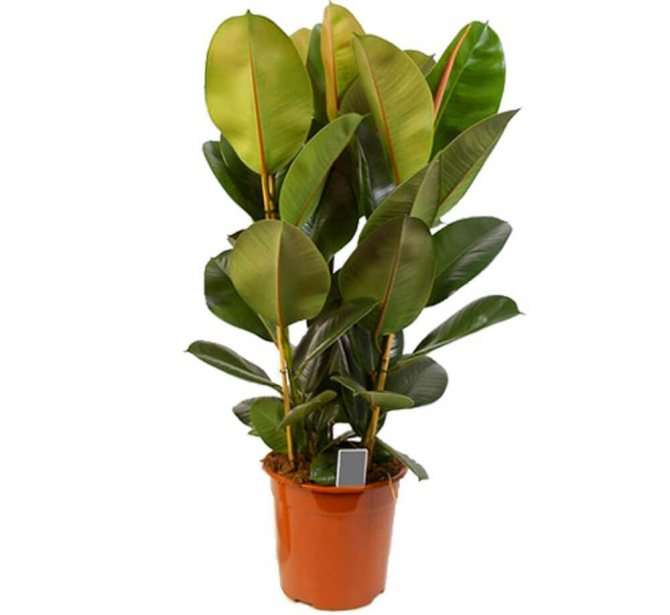

- A suitable option when the plant is given by a friend who has children;
- Ask for a ficus for a while from a married couple;
- Putting a flower near the matrimonial bed;
- Take care of it like a kid, remembering the little things;
- At midnight on the growing moon, walk around the flowerpot naked, imagining how the heir is born.


Experienced growers have proven that ficus:


- Improves mood. During the period of flower growth, substances are released - ethers and phytoncides, which improve the functioning of the nervous system, relieve fatigue. The air is purified from the harmful effects of formaldehyde, benzene and harmful microorganisms;
- Develops public speaking skills. Communication skills improve, thoughts become laconic, there is a gift of persuasion, communication skills. On the other hand, the urge to chatter and cheat goes away;
- Health improves. In combination with other measures, it heals the owners suffering from problems with joints, muscle tissues, spine.


How to avoid the consequences predicted in the signs
Sometimes flower growers prefer not to start a beautiful plant, fearing superstitions and signs. Experts say that first of all it is necessary to take good care of the tree and not tune in to negativity. Only in this case Benjamin's ficus will bring happiness and good luck.
To prevent bad omens, you need to choose the correct arrangement for the flowers in the house. According to superstition, a small tree should not be positioned:
- away from windows and sunlight;
- on the north side;
- on the windowsill by the west window.
These places are unfavorable for growth. Located in an unfortunate place, the flower spends all available strength to maintain its life. Thus, he will not be able to help create harmony and a friendly atmosphere in the house.
Is it possible to give ficus
Ficus was presented - a good sign, especially when the plant is in bloom. The tree will attract good luck, luck, money, the implementation of all plans, family well-being to your house.
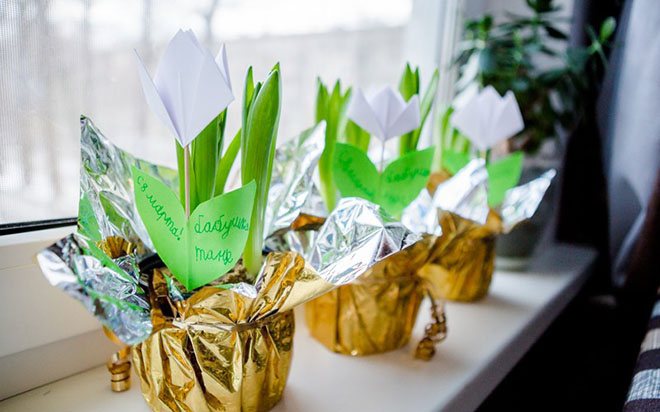

For married couples, such a gift predicts the birth of a baby. The main thing is to surround the flower with care and attention, then he will answer you kindly for good.
Ficus benjamin - signs FOR
According to Ayurveda, ficuses, and especially the variety of ficus benjamin, have a very beneficial effect on the energy in the house. This is a cleaner plant that gladly absorbs all negative from the environment and builds an aura in the house.
Ficus is a symbol of the country of Thailand and is ranked among the sacred plants in it. Thais believe that he brings them happiness and good fortune. It is not for nothing that the inhabitants of this country are considered one of the happiest, friendly and hospitable.
He is also an assistant in family affairs. It very well cleans the air from harmful substances (benzene, phenol, formaldehyde, asbestos, etc.), dust. Saturates it with useful oxygen. Therefore, it is worth taking care of this worker and do not forget to wipe his delicate leaves at least once a week.
If you buy any of the types of ficus (benjamin, rubber, kinky, melanie, elastica, microcarp, black prince, abidjan, etc.) and put it in the kitchen, then it will not only kill all harmful microbes, but also help you cope with excessive desire eat.
And also the ficus brings prosperity to the house. According to the sign, if you dig a coin into his pot and do not forget to water the flower in time, then along with the growth of the plant, your well-being will also grow.
In China, ficuses are on most windows in the country. They are sure that this flower harmonizes the space of the room, and according to Feng Shui it gives comfort. Just what is so often lacking.
general description
This species is an evergreen tree-like shrub with small, elongated green leaves. (up to 4 centimeters long), falling twigs and a lignified trunk. A distinctive feature of the kinky leaves: a yellow-beige or light lettuce uneven strip along the edge of the leaf.
For reference: Division: Angiosperms (Flowering) Class: Dicotyledons Order: Rosaceae Family: Mulberry Genus: Ficus Species: Benjamin Ficus Subspecies: Benjamin Kinky Ficus.
It is native to the tropical climate of Africa, Southeast Asia, India and northern Australia, where it looks like a real tree that grows to 25-30 meters.
Ficus in the house during pregnancy
Ficus benjamin is the protector and guardian of the house. It also helps to harmonize your family relationships and helps you get pregnant. To do this, you just need to follow some rules.
To make your man feel better in bed, put him next to the bed. This will energize your energy and help you get pregnant.
The fig tree (a burning bush in the Bible) according to Christian teaching is a plant that was chosen to manifest pure divine power. So this plant is also a ficus!
Also, if among your friends there are already people giving birth, then you can ask them for a twig, a shoot from their plant. This will help harmonize the energy in your home.
Is it possible to keep ficus at home
Initially, the Slavic peoples believed that this plant attracts gossip and envy of others. Since the iconic flower has a strong energy that frightens off men, he predicted celibacy for women.
However, over time, the attitude towards the plant has changed. Now the ficus in the apartment marks an increase in earnings, a new highly paid position, an improvement in relationships within the family, and the imminent continuation of the family.
Despite the positive magical properties of a flower, its appearance in the house can provoke an allergic reaction due to the content of milky juice in it. If you notice malaise, the appearance of a fever, you need to get rid of the flower in order to avoid the development of asthma.
Where is it better to arrange
According to the teachings of Feng Shui, you need to put a pot with an iconic tree in an apartment or office depending on what area of your life you want to receive support.
- To attract finance to the house, it is better to place the flower in the kitchen.
- Finding a tree in the living room promises new acquaintances with influential people, patrons, sponsors. If you place it next to the TV, you can neutralize negatively charged impulses and the influence of the flow of negative information.
- Ficus in the bedroom will help to cope with insomnia, nervous strain, help to get pregnant and maintain male strength for many years.
- Growing an unpretentious plant in the office will maintain a friendly atmosphere in the team.
- You can not put ficuses in a dark place devoid of good lighting. The sign predicts the extinction of the family fire. The only exception is the bedroom area. Also, window sills on the south side are prohibited, because direct sunlight can burn the leaves.
- You should not put a sacred flower pot in the middle of the room, next to hot radiators and close to neighboring plants.
Currently browsing → Signs and beliefs about birch
Where is the best place to put the ficus
A large number of people are worried about the question - where is it better to put the ficus? The very ancient practice of Feng Shui will help to answer it:
- East side
- South side
- Closer to the light
If you put it in one of these places, then the energy of the plant will be able to open up to its full potential - it will bring peace, peace, harmony to your home and relationships.
Also, for a ficus plant, it is worth choosing a specific room according to your preferences:
Ficus benjamin in the kitchen... It is installed to attract wealth, to establish the monetary sphere. If your goal is to start making money in the near future, then this place is best suited.
Ficus in the bedroom... Helps to normalize sleep, relieve anxiety and nightmares. For a family bed, this is also a great opportunity to get pregnant sooner. To do this, a pot with a plant should be placed near the head or behind it.
Ficus in the living room... The sign says that placed in the common room, it thereby will help to attract the right people into your life. And those who secretly treat you badly, but nevertheless come, will begin to feel uncomfortable and will soon leave your life.
Ficus in the office... This is the most favorable place for creating a pleasant and at the same time working mood. With it, it will be easier for you to delve into any problem, focus on the task at hand.
Conditions for ficus Kinki in the room
Features of growing ficus Green Kinki as a whole boil down to the following activities:
- Providing sufficient sunlight in the room where the plant will be located.
- Finding a promising place so that you do not expose the flower to stress in the future and do not rearrange it to a new place.
- Correct organization of the irrigation system.
- Timely transfer to a large container.
- Application of balanced nutritional formulations in the spring and fall.
If you do not adhere to the basic recommendations regarding the care of an ornamental crop, then soon the dumping of the leaf mass will begin.
Temperature and humidity
Proper care of the Kinki ficus involves maintaining the temperature in the room within 20-25 degrees. In winter, these indicators can be lower by only 4-6 degrees, the critical minimum will be the temperature at around 12 degrees. Homemade ficus reacts poorly to very hot air currents, and based on these considerations, it is highly undesirable to place a flowerpot with a plant near heating appliances.
Since the flower culture comes from the tropics, too dry air is contraindicated for it. In order to maintain a normal humidity level (50-70%) in the room in the summer, you need to regularly spray the leaf mass daily, but only with extremely soft and settled water. If you use water directly from the tap, then the lime will leave completely unattractive marks on the sheet plates. In winter, in conditions of low temperatures, such activities are not recommended. In addition, a warm shower has a beneficial effect on the plant, which is also a preventive measure against such parasitic individuals as spider mites and aphids.
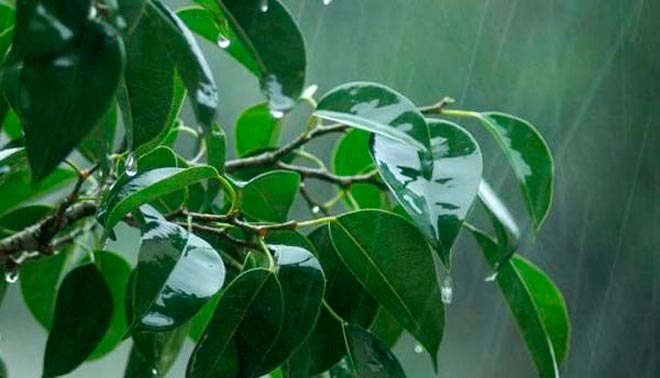

Correct lighting
Ficus Kinki belongs to the category of light-loving plants, therefore, to maintain the green color of the leaves, it needs scattered light in sufficient quantities, so the process of photosynthesis will be quite active. Despite the fact that the flower culture is quite capable of withstanding exposure to direct sunlight, it is better to darken it in the hot season. It is advisable to immediately determine the location of the pot with Kinki ficus. It is recommended to choose a window sill facing east or west.
Pot and soil requirements
To ensure the splendor of the crown of an ornamental shrub, you should choose the right soil substrate. It must be sufficiently loose, air and water permeable. It is possible to prepare fertile soil at home, taking peat, sand and sod land in equal proportions for these purposes.
If the necessary components of a high-quality substrate are not available, then you can purchase ready-made soil for growing ficuses at a specialized outlet, which is very convenient and effective.
Where it is not desirable to put ficus
According to folk omens, there are places where the ficus in the house will not be able to maximize its positive properties:
- Far away from the window
- North facing window
- It is also undesirable to put it on a western window sill.
It will be difficult for the plant to grow in these places, it will spend all its energy on maintaining its life and will not be able to help you.
Remember that any plant is alive and how you treat it, so it will help you with its energy.According to signs, the more you take care of the ficus, the easier it will be for you to live in your house. Quarrels with a loved one will pass and life will go smoothly.
Still have questions about ficuses? Can't decide whether to keep it in the house? Ask them in the comments and I will definitely answer you.
Let your flowers bring joy and happiness to your home.
Signs about the war
Before the revolution in Russia, Benjamin's ficus was a very popular flower and stood in almost every home. This plant symbolized the status of the owners, keeping it in the living room was considered a sign of good taste. However, after the revolution and world wars, superstitious housewives blamed the flower for all troubles, considering it a symbol of devastation and misfortune.
In addition, many women were sure that a man from the war would not return to the house where Benjamin's ficus grows. This is how the omen appeared not to keep the flower in the dwellings where the husband went to the army or is in the combat zone.
to "Signs about Benjamin's ficus"
Good afternoon ._And where can I put the ficus, if all my windows face north and west
Hello - in that case it is better to go west undoubtedly. On the north side, Ficusu (especially Benjamin) will be uncomfortable.
Hello! A couple of years ago, Benjamin's ficus dropped the leaves, almost half. Stands on the east side. Its OK now. He's tune has grown and become more voluminous. What would it mean to drop the leaves? Thank you
Good afternoon! A woman gave me Benjamin's ficus and another ficus, I don’t know what it’s called. But this woman has no children and I now have a problem with that. Maybe it's better for me to get rid of these flowers, maybe the flowers have bad energy?
Good to know
To enhance magical properties, you must follow the rules:
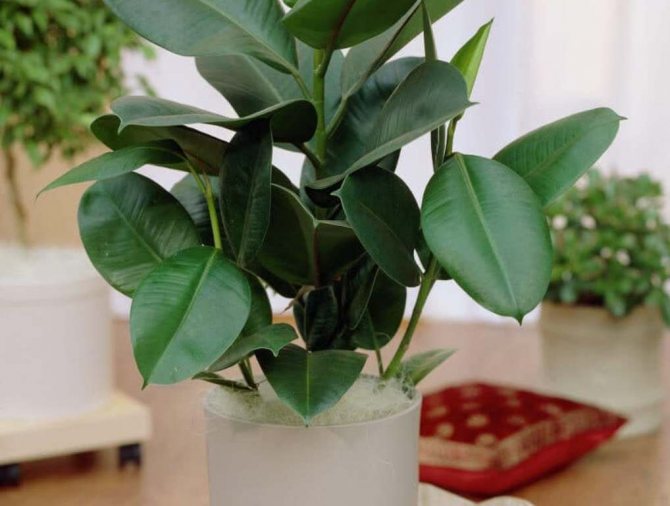

- Place the container with the plant in subdued sunlight;
- Observe the irrigation regime, irrigating every 5-7 days;
- Do not move too often, otherwise the leaves will fall off;
- Spray and dust off.
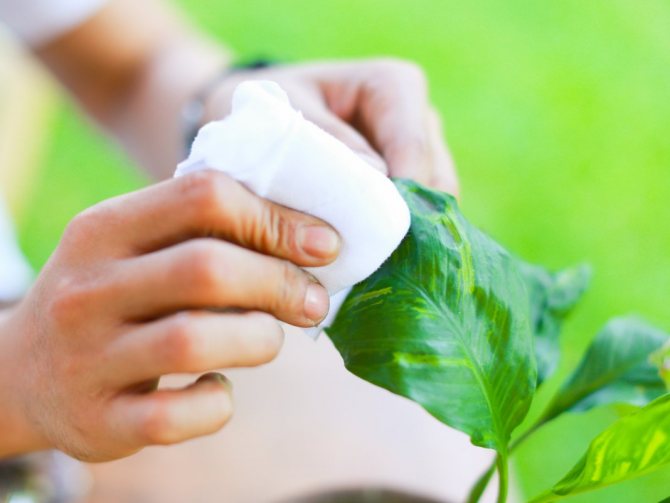

The flower is whimsical and requires constant care. According to Feng Shui, an unsuitable area is in the center of the room and in the northeast. In such places, the positive impact of the plant will be reduced to a minimum. It is not recommended to put in the children's room, the child's body is not strong, it is not known how the effect of the flower will affect it.


Read:
Signs about a ginger cat
A pot in the shade is also an unfortunate decision. Ficus will not like the north window, the strength will go to maintaining its own growth, and not to helping the owner. It is impossible to put on the balcony, the capricious plant does not tolerate drafts, as well as the window sill blown out of the cracks.
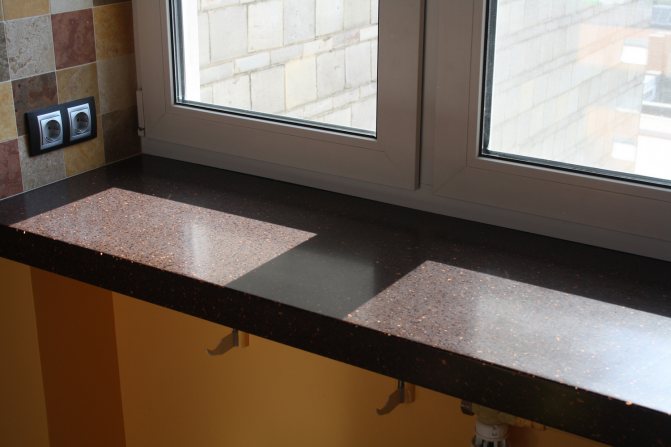

Most of the beliefs about the flower do not pose a serious danger. Prejudice is not a reason to abandon the variety of the interior, so keeping a ficus in your home or not is a personal decision.
What to do right after buying a flower?
You can buy ficus Kinki in florist shops or order online. The cost of a specimen with a height of 27–35 cm ranges from 500 to 1 thousand rubles.
The newly purchased plant needs to be transplanted as the shipping medium is not suitable for growing it. But this procedure should be carried out 2 weeks after purchase - during this time, the ficus adapts to new conditions.
You need to immediately choose a permanent place for the flower, since it reacts negatively to movement and frequent rearrangements can provoke foliage to fall off.
Top dressing
The application of mineral fertilizers begins in the spring with the beginning of the period of active growth of the ficus. Complex fertilizers are well suited for feeding.
Fertilizers should be applied once every 15 days, from early spring to late autumn. In the autumn, the frequency of top dressing is gradually reduced. For plant growth, mineral fertilizers containing nitrogen should be used. However, we must not forget that an excessive amount of this component in the soil can cause the flower to lose its decorative color of the leaves.
Can you keep it at home?
The attitude towards this plant of the Eastern and Slavic peoples is significantly different. If the former considered the ficus to be symbols of happiness in family life, the latter called it a witch tree that brings trouble. Let's get acquainted in more detail with the attitude to the ficus of various nationalities:
- Chinese ficus was perceived as a family plant, which was presented as a gift for weddings, birthdays, and also passed on to descendants. If you believe the beliefs, then it helped to cleanse the room of negative energy, gave people vigor and physical activity, which made it an ideal option for the elderly.
- Thais ficus was also considered a sacred plant and were confident that it was able to ward off evil spirits. It is Benjamin's ficus that is the symbol of Bangkok, the capital of Thailand. And another variety of it became the personification of the island country of Barbados and was depicted on the coat of arms of the state.
- Slavic peoples attributed magical properties to the wax leaves of Benjdamine's ficus, endowed the plant with the ability to bring discord into families, provoke conflicts and lead to separation. Also, Benjamin's ficus acted as a muzhegon - such properties he acquired in the post-war period, when most of the families where the tree grew, lost men who died at the front.
- Benevolently the Bible talks about ficus... So, one of its varieties served as the first garment for Eve and Adam, and the fruits of another type (namely, figs) served as their first food after the latter were expelled from Paradise.
Crown formation
To form the crown of a tree, it is necessary to prune overgrown or dried shoots. We must not forget that the plant secretes a caustic milky sap, which dries very quickly, therefore, care for the plant should be carried out with gloves using a sharp knife or pruner.
If several shoots are planted in one pot, you can form a tree with a lush crown. Over time, the stems will grow together near the base. The hardened shoots can be intertwined, giving the plant a bizarre shape. A single planting can be formed as a miniature bonsai tree.
Is a plant suitable for bonsai formation?
Forming a bonsai from ficus is easy. The main thing to do is to limit root growth by planting the seedling in a small flat container, trim the roots regularly and pinch the top of the plant when it reaches the required height.
You can get a beautiful and original tree without even performing these manipulations. To do this, it is necessary to regularly prune, not only removing all old, dry branches, but also shortening the young ones, giving the desired shape to the crown of the plant.
Expert opinion
Mokhov Andrey Petrovich
Graduated from KubSAU specialty: agronomy
To enhance the bushiness and density of the ficus, it is required to regularly cut the apical shoots.
Also, several specimens of ficus are often planted in one flowerpot at once - this allows you to get a lush crown and intertwine and spliced tree trunks together, giving them the shape of a mesh, braids or spirals. This is possible due to the flexibility that the trunks have until they are fully lignified.
Harm
It is useful to keep ficus in the house, this decorative flower absorbs benzene, formaldehyde, phenol and other harmful substances. But be careful if your family has small children and pets who strive to try everything to the teeth.
The green leaves of the plant are unsafe to health and may require medical attention if ingested.
Allergy sufferers may also be in danger. Some of them will not be able to enjoy the beauty of the ficus tree. The juice of the leaves of some types of ficus contains rubberespecially dangerous for asthma sufferers. However, getting this juice even on the skin of a healthy person can cause irritation.
What kind of soil is needed?
The soil should be nutritious, light, have neutral or weak acidity (pH 5.5–6.5) and good moisture and air permeability.
You can use ready-made soil for palms or ficuses sold in flower shops, or a soil mixture prepared yourself, consisting of equal parts:
- peat;
- coarse sand;
- turf.
To minimize the risk of decay of the root system, chopped charcoal should be added to the resulting substrate.
To disinfect the soil and get rid of the possibly contained mold spores, bacteria, larvae and other dangerous microorganisms, it is necessary to treat it with a weak solution of manganese or steam it.
Transfer
It is advisable to replant young plants every year, it is best to do this in early spring.
Mature plants are usually transplanted after two to three years as needed, as soon as they notice that the plant has become cramped in the pot.
If you bought ficus Kinki in a store, you must immediately transplant it into a suitable substrate.
For a transplant you need choose a container larger than the previous pot.
A layer of gravel or pebbles must be laid on the bottom of the container. To transplant, you need to remove the plant from the old pot in one lump, without damaging the root system, and transplant it into a more spacious container.
Details on how to plant, transplant and care for the Kinki ficus are described in this video:
Reproduction
Reproduction of ficus Kinki is possible in three ways: by seeds; cuttings and pieces of stems.
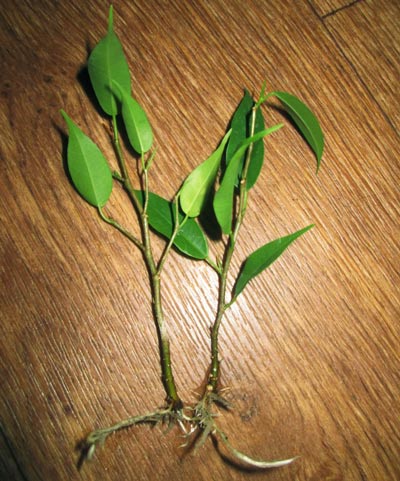

The easiest and most popular way to reproduce at home is by cuttings.
To do this, you need to cut off the upper stalk and with a knife obliquely with several leaves and place it in water or wet sand for rooting.
After about two weeks, the cutting will give roots and must be planted in loose soil.
It is better to cover the plant with a plastic cap at the first stage.
Growing from seeds takes a long time and does not always give a result.
Video
Helpful Home Care Video:
Soil and top dressing
The soil should be slightly acidic or neutral. Since it depletes over time, it needs to be fed with special mineral compounds. This is especially true in the spring, when the ficus begins to actively grow after hibernation. During this period and before the onset of autumn, you need to fertilize the soil at least once or twice a month.
In autumn, the frequency of fertilizing is reduced, and in winter this procedure is no longer required.
Lighting
He is very light-loving, diffused light is best. Direct sunlight can cause leaf burns, and insufficient light leads to a slowdown in plant growth.
Temperature
The optimum air temperature is not lower than 15 ° С and not higher than 30 ° С.
In this regard, you should not place a pot with a plant next to heating devices, as well as in drafts and non-glazed balconies.
Watering
For ficus kinki, moderate moisture will be optimal. Over-watering can damage the root system. Drying out of the soil should also not be allowed. The plant can be sprayed with non-cold, settled water.
Planting and transplanting
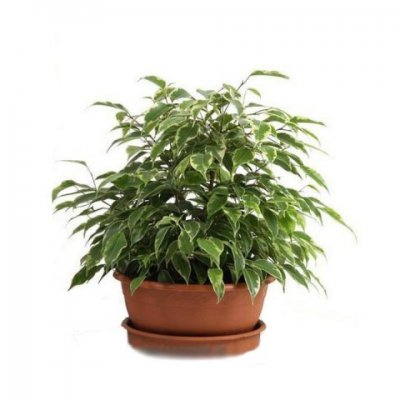

Young shoots are transplanted at the very beginning of spring every year.
Mature plants are transplanted much less often, only when they feel cramped in their old pots.
The sequence of actions when transplanting:
- take a pot with a larger diameter;
- put expanded clay drainage on the bottom;
- carefully remove the ficus from the old pot along with the earthen lump;
- place in a new container and add the required amount of soil;
- water and fertilize.
Crown formation
The branches are growing fast therefore, to form a beautiful crown, they need to be cut off.
This procedure is absolutely harmless to the plant and allows you to get the desired ficus shape: spherical or otherwise.
Useful video on the correct formation of the crown:
Even young stems of kinky can be intertwined with each other as you like. they are quite flexible.
Pruning is best done in spring or summer, so the crown will be more lush.
At work (in the office)


Also, ficus in feng shui is considered a plant that attracts cash flow and financial well-being. For this purpose, it is recommended to place it in the southeastern zone, and for the same reason it can often be found in offices and workrooms, where it:
- increases concentration and concentration;
- creates a working atmosphere in the team;
- helps to smooth rough edges and cope with high loads.
Requirements for conditions
The flower needs comfortable, close to natural conditions, those that reign in the real tropics.
Ficus Kinki needs a well-lit place, but the light must be diffused. It must be protected from hot rays, hot air, since the flower reacts painfully to such phenomena. A pot with a plant is placed from the window in summer, and away from batteries and heaters in winter. It should be protected from drafts, otherwise it will begin to lose foliage.
It is undesirable to change the room where the pot stands, because the plant does not tolerate rearrangement well.
If the flower sheds its leaves, it means that it has become uncomfortable. In this case, you should:
- adjust the room temperature;
- do not change location.
In the room where the flower grows, you need to maintain the air temperature at least 15 degrees Celsius. The optimum temperature is considered to be 20-25 degrees Celsius.
The flower calmly refers to dry air, easily tolerates high humidity. Despite this, you need to try to keep its level moderate, then the plant will be comfortable.
It is enough to periodically spray and wipe the foliage, this is enough.
Description of the species
Ficus Kinki is a compact bush with a voluminous deciduous head. It branches well, and the shoots eventually droop under the weight of a large number of variegated leaves up to 4 cm long. The main stem is straight, covered with dense wood.
There are two types of Kinki ficus:
- one has leaves with a white border around the edges;
- the second has a cream-colored rim.
In variegated ficus, the structure of the leaf plate is more rigid than that of Benjamin's ficus.
The benefits of a flower
Ficus is one of the first indoor plants studied in detail by biologists. According to research carried out, this flower, being in an apartment or house, serves as an air filter: it not only absorbs harmful substances (formaldehyde, phenol, benzene, etc.), but also saturates the surrounding air with oxygen. The absorbed toxic substances are converted into amino acids and sugars through a series of chemical reactions that take place in the leaves of the plant.
The indisputable advantages of ficus include its ability to sanitize the surrounding space, destroying harmful bacteria. In addition, he is a transformer of a person's emotional state, turning negative thoughts into positive ones. Thanks to its beneficial properties, this plant will become an excellent neighbor in the bedroom and children's room, guaranteeing healthy sleep for babies and quality rest for adults.
The flower will take root in the kitchen: it is believed that its presence contributes to better saturation and abundance of food on the table. To protect the house from the evil eye, the plant is placed on the closet in the hallway. so that it is above the heads of guests who come to the house.
Care
After purchase, the ficus must be transplanted into a plastic or ceramic container. The pot should be 2-4 cm larger than the previous one. If the transplant is not done, the flower will begin to shed its leaves.
Transfer
For the first transplant, prepare loose, fertile soil. This can be a purchased mixture or a self-prepared substrate. You will need:
- peat;
- sand;
- leafy land.
The ingredients are taken in equal proportions, mixed, and drainage from small stones is added. It turns out a weakly acidic or neutral composition of the earth.
A drainage layer is poured onto the bottom of the container. The transplant is performed by the transshipment method, when a plant with the same earthen lump is placed in a new pot.
The free space is filled with the prepared substrate. It is tamped, watered abundantly.
In the future, the transplant is performed when the need arises. The frequency of the procedure depends on:
- the intensity of the growth of the roots of the flower;
- flower growth.
After transplanting, you should decide in which room the pot with the plant will stand. This is done taking into account the requirements for the conditions.
After that, it is enough to follow the rules for caring for a flower at home, and it will delight you with an attractive appearance.
Watering
Water the ficus sparingly so as not to overmoisten the soil. This is fatal to the flower. The matter is complicated by the fact that the plant itself is small in size, and the container in which it grows is small. This prevents good evaporation of moisture from the soil.
Excess water leads to:
- decay of roots;
- the appearance of a fungus.
The earth should not be allowed to dry out, because of this, the leaves turn yellow and fall off.
Top dressing
Feeding the flower is carried out regularly, because the soil is gradually depleted, the plant lacks minerals. Fertilizers are applied according to a specific scheme so that there is no excess of minerals. Because of it, the plant can shed its foliage.
The first time the composition is applied at the beginning of spring, when the flower comes out of a state of dormancy. At this moment, and before the autumn cold weather, a complex or special fertilizer is used. It is applied 1-2 times every 30 days.
From the beginning of September, the frequency of fertilizing is reduced, in winter they are not needed.
Pruning
Flower pruning is performed only to form the crown. This procedure does not harm the plant.
For greater effect, several young plants can be planted in one container, intertwining their flexible trunks. As it grows, in the spring or summer, pruning is carried out. As a result, one voluminous flower with a lush crown is formed.
Reproduction
Ficus Kinki propagates by seeds and cuttings. The first option occurs in nature, only cuttings are used at home.
To grow a flower you need:
- cut a stalk from its upper or side branch;
- wait for the milky juice to dry on the cut;
- place the stalk in water.
When the roots appear, the ficus is planted in a nutritious soil, then covered with glass or a bag, this allows you to create greenhouse conditions. The shoot is placed in a lighted, warm place.
The root system develops already 2 weeks after planting. After a month, the stalk can be planted in a permanent container with a diameter of 8-10 cm.
If you care for the Kinki ficus correctly, creating the necessary conditions for growing it, for many years it will delight others with a lush, spectacular crown and original appearance.
One of the most decorative is the Kinki variety - this is a variety known to everyone. Such a plant received a large number of small leaves from its parent, but differs from it in their variegated color and its more modest size.
The second name - variegated ficus - the flower received precisely because of the two-tone tone of the leaves.
How to choose in the store
There are several important rules to consider for a successful purchase.
- It is better to take a fresh copy that has just been delivered to the store. You can determine the degree of freshness as follows - shake its crown, with significant shedding of foliage, it is better to refuse such a plant. Ideally, all leaves should remain on the bush.
- Ficus is often damaged by mealybugs, so it is worth carefully examining the steles and leaves. You can identify the parasite by whitish bloom and small white insects.
- In strong and healthy plants, the branches are whole without cracks, breaks, outgrowths, the leaves do not contain yellow spots, black blotches.
Effects on pregnancy
One of the most famous signs about ficus is associated with its influence on the birth of children in a family. It is believed that the flower can help you get pregnant.
Before purchasing a flower, many people are guided by the superstitions and omens associated with them. Beliefs can be not only positive, but also negative. There are also signs and superstitions about Benjamin's ficus, which is a popular plant.
Pests. Table
| Pest | Signs | How to get rid of |
| Spider mite | A thin white cobweb appears on the leaf stalks, black dots on the inside, and yellow spots on the outside. | 1. Wipe the foliage with a soap-alcohol solution; 2. Every 5-12 days (depending on the degree of damage) to carry out treatment with acaricides ("Omite", "Flumite", "Apollo"). |
| Shield | On parts of the plant, growths of a gray-brown color and a sticky coating appear | Carry out the treatment with "Aktara", after a week spray the ficus and the soil with "Metaphos" or "Fufanon" |
| Mealybug | Dirty white pellets resembling cotton wool form on the plant | Wipe the leaf plates with an alcohol solution, spray the ficus with "Commander" or "Fitoverm" |
| Aphid | Leaves turn pale, covered with white bloom, fall off | At the initial stage of the lesion, spraying with herbs that have an unpleasant odor can help; if the problem does not go away, it is necessary to use "Aktara" or "Inta-Vir" |
Benefit and harm
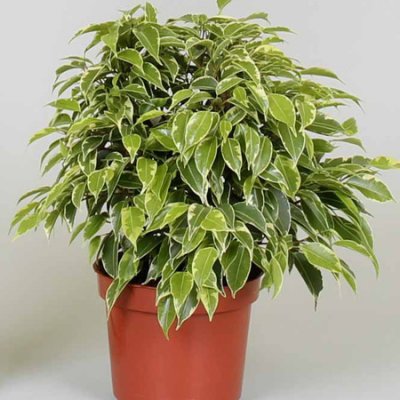

Benjamin kinki's ficus is practically harmless, unless of course you try to eat it.
It has a beneficial effect on the indoor climate. Namely, it humidifies and purifies the air from harmful substances of formaldehyde and benzoic groups.
Ficus has a number of medicinal properties used in traditional medicine.
It is used to treat:
- various hematomas;
- radiculitis;
- osteochondrosis;
- cysts at the base of the gums;
- mastopathy;
- myoma and other benign neoplasms.
And those families who want to have children are also advised to purchase this plant.
Is kinki suitable for creating bonsai
This dwarf plant is ideal for creating bonsai, and the formation is possible in several variations:
- moyogi - a vertical bush with a slightly curved trunk and branches growing in different directions;
- shakan - the central conductor is curved, with branches at the top, located to one side;
- hokidachi is a broom-shaped tree with a wide and dense crown.
Such a plant can be grown from an apical shoot 10-12 cm long. The cut on the cutting is dried, then sprinkled with charcoal, and placed in a root formation stimulator.
In order for rooting to be successful, greenhouse conditions are created at a temperature of 22-24 ° C.
After the development of roots up to 4-5 cm in length, they are planted in a pot with drainage holes. For good growth, they provide diffused lighting for 12 hours a day and high humidity - 75-80%.
When the seedling reaches the required height (20-25 cm), they begin to form it - the top of the main branch is pinched off by 1-2 cm. In the future, to obtain a dense crown, the pinching is repeated every six months.
Reproduction
Reproduction of ficus Kinki is carried out using apical cuttings. A suitable shoot must be cut off with a sharp knife. The shoot length should be at least 10 cm, and at least 1-2 leaves should be present on it. Milky sap is formed on the cut of the cutting, which must be washed off with warm water, and then the shoot is dried. The prepared stalk is rooted in the nutrient mixture and covered with glass or a bag to create greenhouse conditions. Shoots are placed in a warm and bright place. The first roots will start to form in 2 weeks. 1 month after planting the cuttings, they can be planted in permanent pots with a diameter of 8-10 cm.
Breeding specifics
Knowing how to transplant home ficus, you can constantly stimulate its further development.But special attention should be paid to the peculiarities of plant reproduction. In the case of ficus, you need to use the apical shoots. They take root well in new soil. Cut a stalk from the height of the plant and place it in a special nutrient composition, covered with glass or plastic bag on top. When, after a while, the shoots release the roots, they can be safely planted in a new pot.
Plant pruning
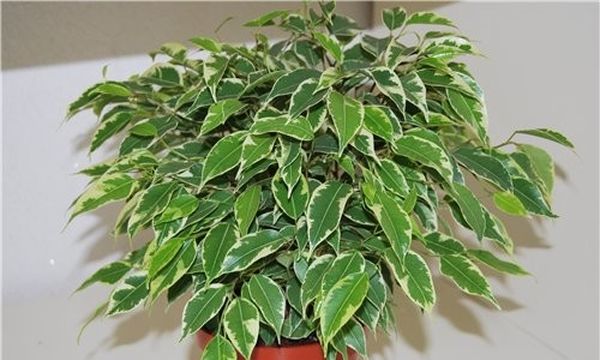

Almost any houseplant can reach impressive sizes, but this floral specimen is appreciated by experts for its decorative effect and miniature height. The task of any Kinki ficus owner is to form a lush, branched crown. That is why the plant height needs to be shortened from time to time. Some growers prefer to plant several shoots in the soil at once. Then, over time, the trunks can be intertwined. This will form a lush houseplant.
Diseases
If the rules of agricultural technology and maintenance are violated, the ficus kinki becomes weak and becomes infected with various infections.
Gray rot
A fungal infection affects the leaves - at first they become covered with brown spots, then completely darken and fall off.
It is necessary to remove the damaged fragments, then treat the plant with one of the fungicides.
Powdery mildew
Another fungal disease, which manifests itself in the form of a white powdery coating on the surface of leaves, stems, and also in the sinuses.
At an early stage of the lesion, the flower is wiped with soapy water, removing the remains of plaque. Launched specimens are treated with fungicides.
Cercosporosis
The causative agent of the disease is a fungus that parasitizes primarily on the leaves - small black or brown dots appear on their surface. Over time, they grow and cover the entire leaf plate, as a result of which it turns yellow and falls off.
Antifungal drugs are used for treatment.
Anthracnose
A sign of infection - the edges of the leaves are covered with rusty spots, later they develop into sores, the leaves die off. At an advanced stage, the plant dies. Treatment is carried out with fungicides.
Root rot
The main reason for root decay is their frequent waterlogging. Such a plant can no longer be saved, so it is removed from the pot and disposed of along with the soil.
Transfer
What to do right after purchasing the Kinki ficus? After you have purchased a flower, you need to transplant it immediately, because they sell the plant in small pots. Also, the soil in which the flower is sold is not used for permanent cultivation. Ficus Benjamin Kinki is transplanted into a pot 3-4 cm larger than the previous one and completely replace the old soil. It is better to choose a pot of ceramic or plastic. At the bottom of the pot, you need to lay out a few stones for good drainage, and then the prepared soil. Ficus Kinki is placed in the middle of the pot and the remaining soil is poured on top. Next, the soil is carefully tamped so that the soil tightly envelops the plant, and watered. In the future, the flower is transplanted annually.
Watering
The main rule in watering is not to overmoisten the soil, otherwise the flower may die. Ficus Kinki is quite small in size, so the moisture in the pot evaporates slowly. Stagnant water can lead to root rot. Watering should be moderate and the soil should not be cracked or wet like a swamp.
Kinki ficus has no requirements for air humidity. The plant copes well with dry air. Periodically, it is recommended to remove dust from the leaves with a damp sponge and once every 3 months give the flower a warm shower. The most obvious advantage of such a variegated tree is its relative simplicity. Home care for the Kinki ficus consists primarily in timely watering.
Video
An interesting video on weaving various decorative forms from the ficus "Benjamin Kinki":
If you find an error, please select a piece of text and press Ctrl + Enter.
The Kinki variety is one of the most attractive types of Benjamin ficus. A dwarf plant of the Mulberry family - a native of the Asian and African tropics. Proper care of this small tree with a luxurious crown will allow its owner to grow an exquisite decorative element and a real decoration for any interior.
Pruning
According to experienced florists, ficuses can be given thickness and texture, for this, two trunks can be planted in an interlaced form, after a while they form a plait or braid, and beautiful growths will turn out. Novice growers or amateurs should practice a little bit of pruning Benjamin kinki young ficus.
The pruning process involves removing the tops of well-developed leaves so that they have young buds. In addition, circumcision is also used in order to maintain the beautiful shape of the flower, so the procedure must be performed every 4 years. At the same time, do not forget to process the cut points using charcoal so that the milky liquid does not flow out.
The planned pruning of ficus occurs in the month of February, the stems are cut, which have become too elongated over the winter. There are several methods of cutting a flower, for example, in the form of a trunk or a bush, and sometimes such a plant is formed as a bonsai.
Soil and fertilizing
The soil should be loose and fertile. In a flower shop, you can buy ready-made soil for ficuses or create a substrate yourself. To prepare the substrate, you need to take the following components:
- peat (1 part);
- sheet land (1 part);
- sand (1 part);
- drainage from small stones.
Over time, any soil is depleted, and you need to fertilize the Kinki ficus between March and September. It is necessary to feed the flower during active growth with complex and mineral fertilizers. Usually the flower is fertilized once every 30 days.
Views
Plant occurs as a specimen with intertwined trunks, tall or low ... Small foliage of rich green color with white splashes makes it stand out in the interior.
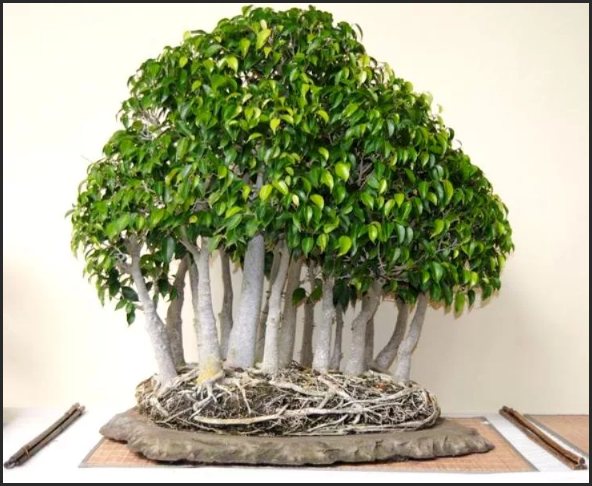

There is another variety of this plant, it is cultivated like bonsai... It looks no less original because of its diminutiveness and at the same time the splendor of the foliage.
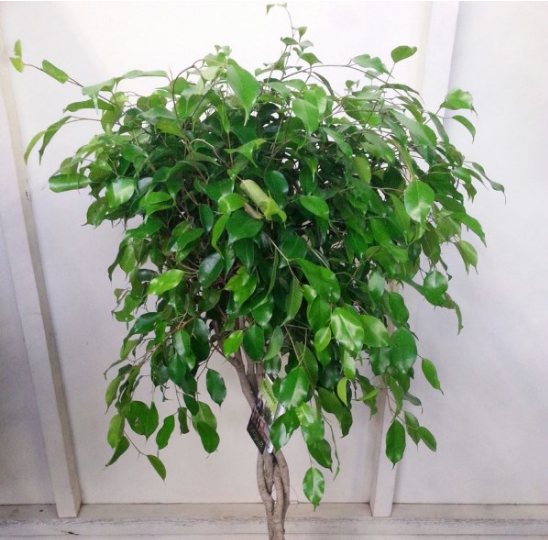

Exotic.
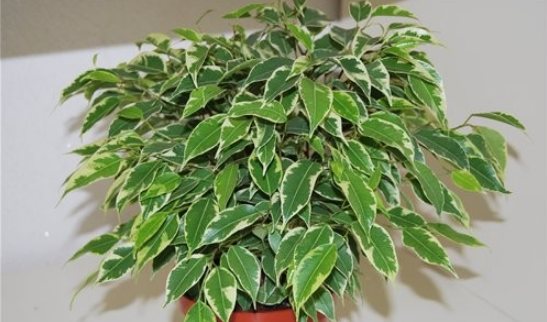

Kinky.
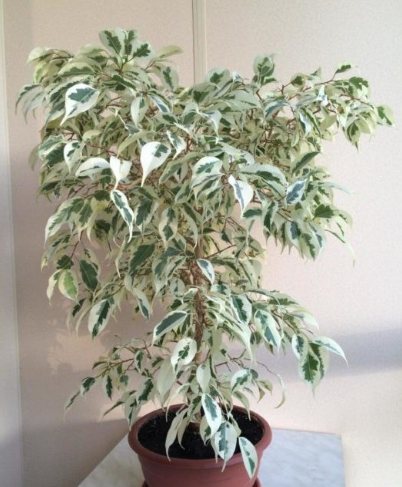

Scarlight.
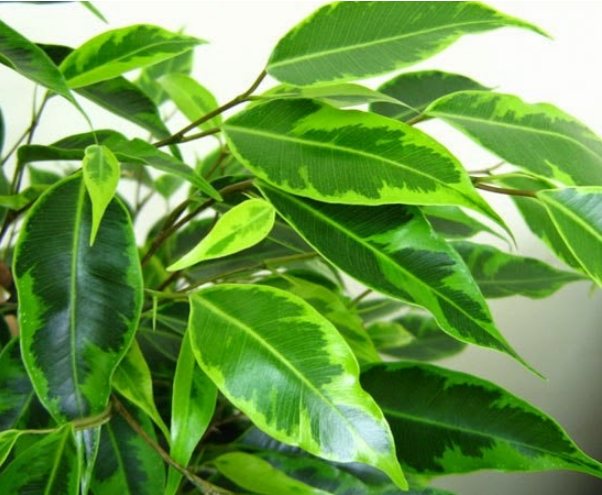

Anastasia.
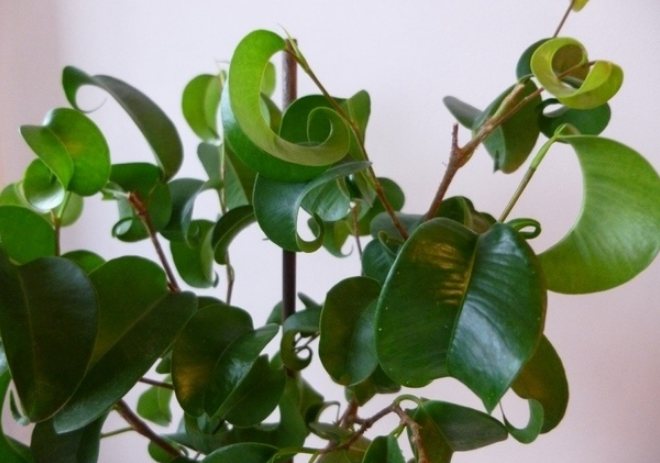

Boucle.
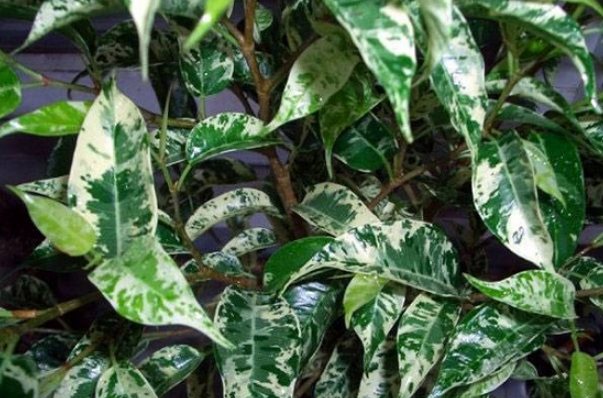

Safari.
Despite the fact that the plant is loves bright rooms, the penetration of direct sunlight is still not for him. Also, the plant does not like too much heat, so it is worth making sure that the temperature is not higher than 25 degrees. From too hot air, Benjamin's leaves begin to fall off.
Home care
After purchasing the flower, it is best to transplant it into a small ceramic or plastic pot, not forgetting about the drainage.
Otherwise, there is a possibility that the leaves of the plant will begin to fall off due to the store soil.
In the photo ficus "Benjamin Kinki":

